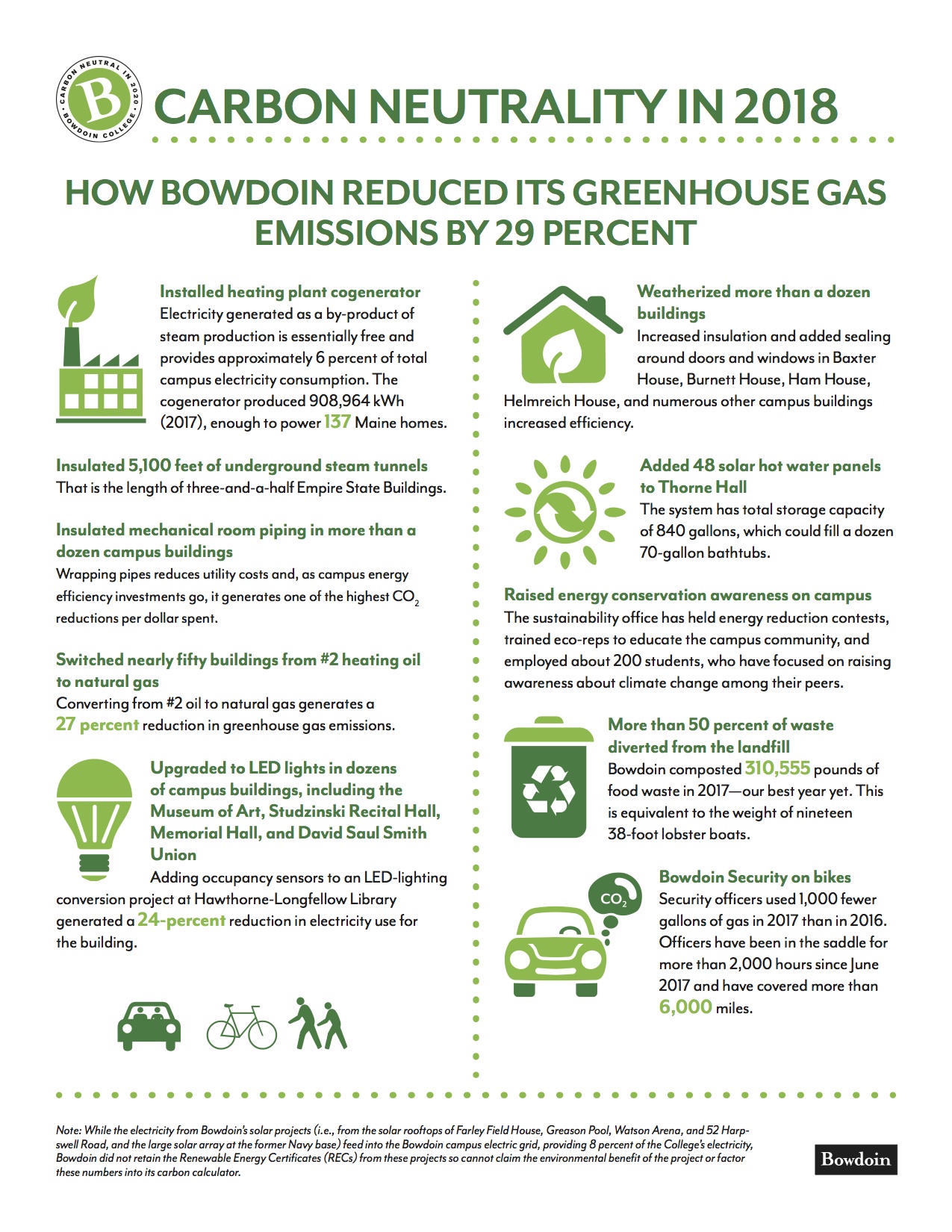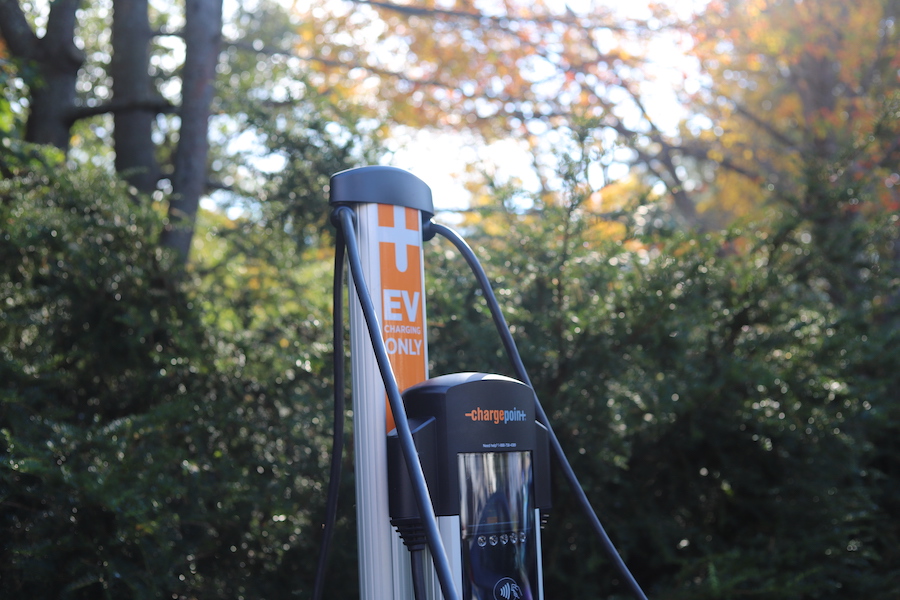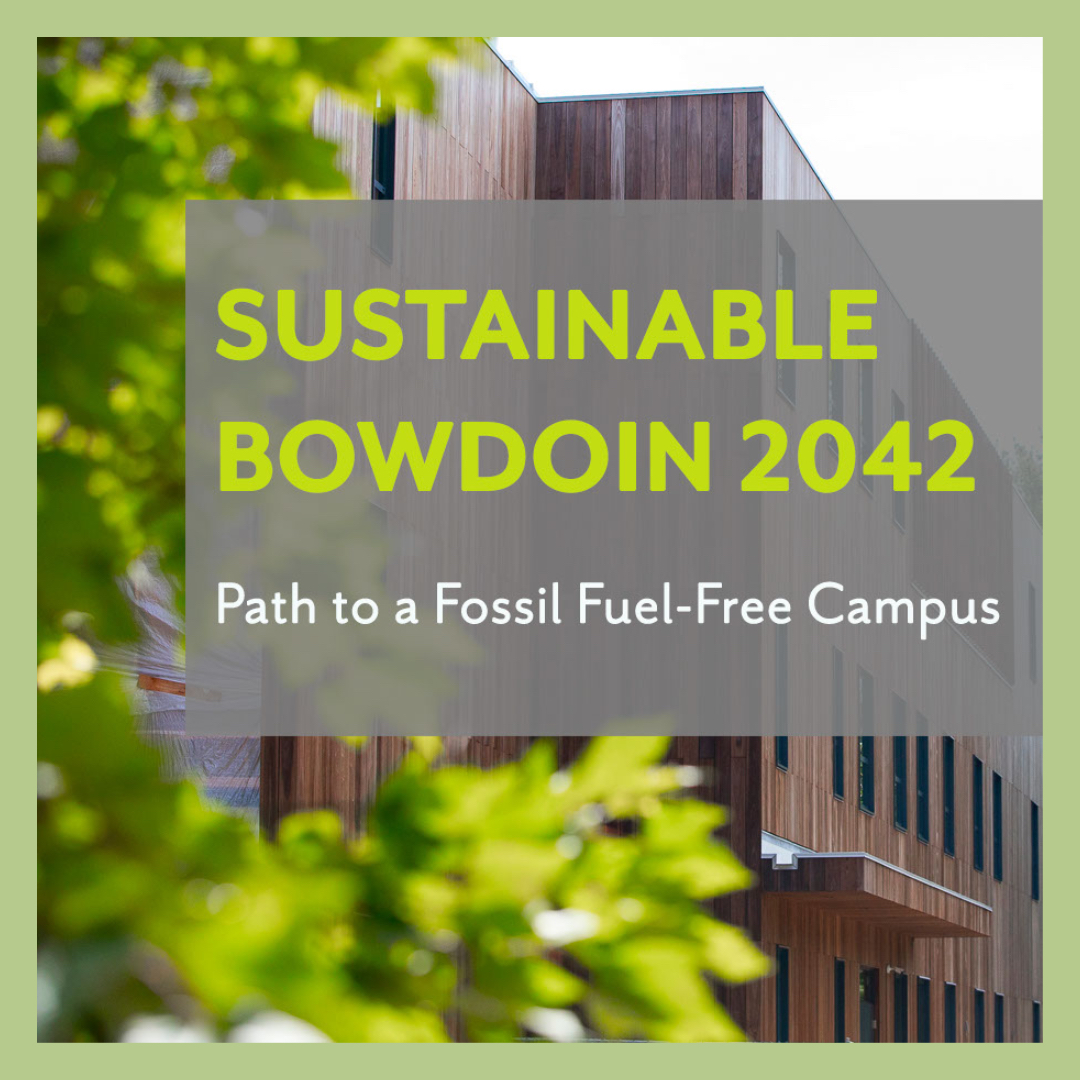Bowdoin Achieves Carbon Neutrality. Now for the Next Step.
Additionally, Bowdoin is also announcing a pioneering renewable energy project partnership that will result in the largest solar array in the state of Maine.
Through a variety of energy projects, campus engagement, and a greening of the Maine electrical grid, the College has reduced its onsite carbon emissions by 29 percent—surpassing its original goals. Using 2008 as the baseline, Bowdoin originally calculated its onsite greenhouse gas emissions at 16,326 metric tons; in 2017, these were cut to 11,620 metric tons.
To account for these remaining emissions, Bowdoin is investing in carbon offsets with regional impacts, and in renewable energy credits (RECs) associated with wind farms. These tools will help the College maintain a net-zero carbon footprint as it continues to actively pursue ways to reduce its greenhouse gas emissions. Next year, after launching a campus-wide initiative to gather input from students, staff, and faculty, Bowdoin will present an updated Climate Action Plan, with specific goals to meet by 2030.
To achieve the milestone of cutting its emissions by nearly 30 percent, College has updated much of its campus infrastructure. These projects have included installing a cogeneration turbine (which produces electricity as a by-product of generating heat), converting buildings from oil to natural gas, insulating pipes, and replacing thousands of lights with efficient LEDs.
“By achieving carbon neutrality two years ahead of schedule, Bowdoin College is demonstrating the leadership and innovation needed to help meet the shared goals of the Climate Leadership Network,” said Tim Carter, president of Second Nature, the organization that monitors progress on the Presidents’ Climate Leadership Commitments.
See the infographic to learn more about the steps Bowdoin has taken to curtail its emissions.

An investment in Maine
As a major part of its commitment to sustainability and a clean energy future, Bowdoin is also contributing to a large renewable energy venture in western Maine. The College has joined four other liberal arts colleges—Amherst, Hampshire, Smith, and Williams—to help fund NextEra Energy’s construction of a 75-megawatt solar project in the town of Farmington. Competitive Energy Services, based in Portland, Maine, acted as advisor to each of the colleges.
The nearly $100 million project will support roughly 180 short-term jobs through the construction phase, as well as at least six full-time, permanent jobs once it is functional. The solar panels will cover roughly 350 acres, most of which are located at Sandy River Farms.
When this utility-scale power facility goes online by the end of 2019, it will be the largest solar array in the state. (By comparison, the Bowdoin solar project built in 2014—consisting of a solar field at the former Brunswick Naval Air Station and rooftop solar at the Farley and Watson athletic facilities—is a 1.2 megawatt system. At the time, that was the largest solar array in the state.) Bowdoin’s share of the RECs created by the new Farmington solar complex will offset close to half of the College’s annual electricity consumption—the equivalent of 1,300 metric tons of greenhouse gases, or a little more than 11 percent of Bowdoin’s total emissions.
“Today at Bowdoin, we celebrate the dual milestones of carbon neutrality and this promising and innovative solar project with our partner colleges from Massachusetts, but we are far from done,” said Bowdoin College President Clayton Rose.
“In the coming year, we will be working with members of our campus community to put forward ambitious new plans at the College focused on greater sustainability achievements and environmental stewardship. In the meantime, it is a point of great pride that Maine will be home to this new source of clean solar energy and, that for the second time in recent years, Bowdoin is helping to establish the largest solar facility in our state.”
The Bridge: Offsets and RECs
When the Farmington project is up and running, the College will decrease its purchase of carbon offsets and RECs that are associated with other projects. Keisha Payson, head of Bowdoin’s sustainability office, describes the investment in carbon credits as temporary measures, or “bridges,” to ensure Bowdoin maintains carbon neutrality while the College works to reduce its planet-warming emissions even more in the coming years.
“We anticipate that as we continue to produce fewer greenhouse gas emissions, this number will decrease substantially over the next decade,” Payson said. “Meanwhile, we’re taking a diverse portfolio approach.” The College’s current portfolio includes offsets from a methane-capture project at a landfill in Berlin, N.H., one mile from the Androscoggin River that flows through New Hampshire and Maine, including Brunswick. The captured methane will be reused as an alternative fuel. This project will offset 9,790 metric tons of carbon emissions. Bowdoin is also buying RECs from three Texas wind projects to offset another 2,800 metric tons of carbon.
Carbon offsets and RECs are designed to help spur the renewable energy market and slow global warming. Offsets are typically achieved by financially supporting projects—often renewable energy ventures, methane-capture projects, or forestry conservation—that reduce the output of greenhouse gases.
RECs work slightly differently than offsets, but also can “prime the renewable energy pump,” said Associate Professor of Economics Erik Nelson. Once an entity generates one REC (one megawatt-hour of renewable energy) it can sell that to buyers interested in offsetting their own emissions. When more entities like Bowdoin demand RECs, their price will rise. “This sends a signal to utilities and other entities that RECs are increasingly valuable. So now when a utility is thinking about either constructing a new natural gas plant or a solar array, they may opt for the solar array even if it is more expensive because the REC revenue will more than cover the difference,” he added.
In this way, the five-college consortium is incentivizing a huge new source of renewable energy in New England. If the colleges had not agreed to buy RECs from the NextEra project, the Farmington solar array would have been one-third smaller. The RECs provide the project with longterm financial stability and, at the same time, allows each college to retain the environmental attributes (i.e., claim the carbon offsets) associated with its generation of clean energy.
“While we continue to aggressively pursue energy efficiency projects on our campus, it is exciting to play a role in the expansion of solar energy and green jobs in Maine,” said Matt Orlando, Bowdoin’s treasurer and senior vice president for finance and administration. “Working with our peer schools demonstrates the need for collaborative partnerships to address climate change.”
An Updated Climate Action Plan for 2030
Now that Bowdoin has reached its goal of carbon neutrality, it will continue to work on decreasing its reliance on fossil fuels. In the fall, the College will kick off a campus-wide initiative to develop specific 2030 sustainability goals and a plan to meet them. The Climate Action Plan 2.0 will be released by next summer.
“Though we are excited to have met this initial milestone of carbon neutrality, we realize our work is far from over and we are eager to focus attention on what comes next,” Payson said. “While we can celebrate progress and evaluate setbacks each year, reducing campus greenhouse gas emissions will require ongoing action by everyone on campus.”
Meanwhile, these are some future projects Bowdoin is already committed to:
- When the Roux Center for the Environment opens next fall, serving as Bowdoin’s hub for the interdisciplinary study of the environment, it will be certified as LEED platinum. Among other sustainable features, it will have a green roof garden and eighty-six solar panels.
- The College is building a complex of four new passive-house residence halls for upperclassmen. This type of energy-efficient building has thick, or “super” insulation, triple-pane windows, and efficient air-exchange systems for heating and cooling, leading to a 50 percent reduction in energy use (compared to a more traditionally constructed building).
- The College has started planning for the Schiller Coastal Studies Center, which will serve as a cutting-edge research center, residence, and conference location for students, faculty, and visiting scientists to pursue the study of the oceans. One of the goals for the project will be to minimize energy consumed by the facilities.
- Additionally, Bowdoin will continue to convert more light fixtures to LED bulbs, weatherize more campus buildings, add hybrid and electric vehicles to its fleet, and install more energy efficient heating and cooling systems across campus.



